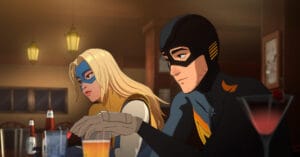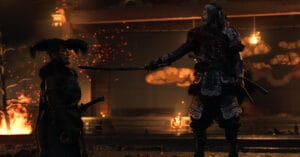In the demo review of Final Fantasy XVI, I was very enthusiastic, as you can see here. I rewarded the demo with a whopping 10. After an enormous amount of hours, I have now also completed the full game. All main and side quests are done, so I can proudly (and at the same time shamefully) say that my first Final Fantasy adventure has come to an end. Has the full game managed to maintain the high rating? Find out in this spoiler-free Final Fantasy XVI review.
Small side note: Personally, I couldn’t care less whether Final Fantasy XVI is a bad RPG, a good action game, or a disappointing chick flick. The only question I’ll ask myself here is whether I enjoyed the game. After all, that’s what it’s all about, right?
I actually planned to release this review much earlier. However, it goes against my principles to write a review without completing all the main and side quests first, in order to form the most complete picture possible. I thought I would be able to get this done quite fast. Nothing could be further from the truth. Final Fantasy XVI is a gigantic game that I’ve spent about a hundred hours on. Every time I thought I was approaching the end, another wave of quests emerged. If I had only been presented with 1/3 of the game, I would probably already have been satisfied with the content that Final Fantasy XVI had to offer.
There are several major highlights that Square Enix‘s creation has to offer, and one of them is the story. Since I want to keep this review spoiler-free, I unfortunately can’t elaborate too much on it. The first few hours are already packed with memorable moments, and it’s best to experience them firsthand.
The Story in Very Broad Terms

To not leave you completely empty-handed, the story revolves around protagonist Clive Rosfield. Clive is the First Shield of Rosaria, which means he must protect his younger brother Joshua. Joshua is the Dominant of Phoenix. Dominants are blessed with the ability to host Eikons. Eikons are gigantic, powerful creatures that represent elements such as fire, wind, and electricity.
These Eikons are valuable in the struggle for political power and are crucial in wars. Politics thus play an important role in the game (one of the reasons it sometimes feels Game of Thrones-like).
Valisthea, the realm where the game takes place, contains multiple Mothercrystals. These Mothercrystals are sources of magic. However, there are also bearers—people who can summon magic without the aid of a crystal. These bearers are marked with a tattoo on their cheek, and most people in Valisthea treat bearers as slaves.
Clive wants to take a stand against the mistreatment of bearers and must destroy the crystals scattered throughout Valisthea to achieve that.
Active Time Lore
Let’s leave it at that for now. And if you’re anything like me, you’re probably already lost with unfamiliar terms like Eikons, Dominants, and Bearers. Add to that the different realms, political powers, and important individuals, and before you know it, you’ll be mixing everything up.
Square Enix has come up with something brilliant to address this. At any moment, you can hold down the touchpad, and the Active Time Lore appears. It then reminds you of everything relevant within the context. It provides information about the important characters in the respective cutscene, the location, and the applicable terms.
It’s a fantastic invention. Hopefully, more expansive games will adopt this feature. I also wouldn’t mind having it during TV series. Shows like Game of Thrones or The Witcher would definitely benefit from it.
Characters

One of the things that naturally contribute to crafting a good story are the characters. Since we’re spending about a hundred hours with our main character Clive, it’s important that he’s a likable guy to have under our control. And luckily, he is.
The game spans a long period, and we see Clive in different stages of his life. When we first meet him, he’s fifteen years old. Clive is immediately very likable. Despite enjoying a lot of respect due to his family background (his father is Archduke of Rosaria), he never treats his subjects as…well, subjects. We even see that he, unlike many others, treats bearers as real people.
Clive is close to his younger brother Joshua, his father Archduke Elwin, his childhood friend Jill, and his loyal canine companion Torgal.
Clive wants the best for everyone, making it easy for players to want the best for him too (and not just to avoid a Game Over screen). The only thing I can point out is that at times, he may have been a bit too much of an ideal son-in-law. I know, it’s similar to when a potential employer asks you about your weaknesses, and you respond with, “Sometimes, I’m too eager.” But sometimes, Clive could have used a bit more fire in his belly, rather than on his sword.
The moments when he does step out of line are brilliantly portrayed by voice actor Ben Starr. He manages to convey a tremendous amount of emotion through the protagonist’s voice, further enhancing the many emotional moments that the story has to offer.
Clive is supported by a largely equally likable cast. Each important character players encounter on their adventure is provided with a rich background. They all have their strengths and weaknesses. The game’s lengthy duration almost naturally builds friendships. I noticed that with some characters at the beginning, I was like, “Who’s that oddball?” But by the end of the game, I understood their motivations, their fears, and I genuinely cared about their fate.
Conversely, it seems to develop the same way. Of course, we start with a few close bonds, but most of the new characters Clive meets don’t immediately embrace him with open arms. Over time, they gradually open up to him and address him in a more familial manner.
The villains are also well-developed characters, and their own goals and motivations are clear (thanks in part to the Active Time Lore). Final Fantasy XVI takes the time to properly introduce everything and everyone, resulting in the main quest being filled with impactful and satisfying moments.
Gameplay

Not unimportant; the gameplay itself. Since I’ve never played a Final Fantasy game before, I can’t (fortunately) join in the turn-based/non-turn-based debate. Not everyone was happy with Final Fantasy XVI having real-time combat, but you won’t hear me complaining. I found the combat to be smooth and responsive. Attacks, especially those from your Eikons, feel pleasing and often look spectacular. Executing a well-timed perfect dodge feels satisfying with the short slow-motion animation, and the transition from defense to attack and vice versa never bored me.
Unfortunately, executing those perfect dodges is not always easy. And if it were solely due to unpredictable, powerful enemy attacks, I would be fine with that. However, defending is sometimes made more difficult by the visual spectacle happening on the screen. The downside of visually spectacular Eikon attacks is that the enemy sometimes gets lost in a sea of fireballs, storms, or electricity. It’s frustrating that sometimes you can’t see when an enemy is launching an attack, let alone dodge it in time.
As you make short work of enemies, you accumulate Ability Points. These can be used to further upgrade your general battle skills and Eikon abilities. Some Eikon upgrades not only become stronger but also gain cooler animations. That makes it motivating to save up points to master your favorite abilities. Once again, it’s a simple system that shows Square Enix wants to tap into a new market of players.
Main Quest

As mentioned, the number of quests is enormous. The big amount of side quests definitely add a lot of hours, but the main quest itself is also far from lacking.
Not only is the quantity of main quests high; the quality is immense. The reason I was immediately sold after playing the demo is that the story of the main quests grabbed me by the throat from the start. Even in the first few hours, there were so many incredible and emotional moments. I was curious if the game could maintain that momentum after the demo, and the answer has been a resounding yes.
Of course, it can’t always be a party. Occasionally, Final Fantasy XVI takes a step back, but even during those moments, I had a great time. These are the moments where you interact more with your friends and connections or learn new things about the world. But that’s just the calm before the storm. When the game truly unfolds (and believe me, that happens often), my jaw sometimes dropped at the incredible spectacle I witnessed.
I’ve played a lot of games in my life, but rarely have I experienced such epic moments. Because that’s a word that perfectly describes these moments. That, and jaw-dropping.
In addition to these moments, the emotional aspect of the story also touched me. Final Fantasy XVI tells a beautiful story that sometimes moves and sometimes exhilarates. The mix kept me on the edge of my seat throughout.
Side Quests
Alright, enough praise for now. Unfortunately, I’m less enthusiastic about the side quests. While there are certainly interesting quests among them, the majority failed to hold my attention. Not surprisingly, many of them are fetch quests. Go here, defeat some monsters, and bring this back. If they had at least contained fascinating backgrounds, that would have been fine (like the side quests in The Witcher 3, for example).
I often caught myself, consciously or unconsciously, no longer listening to the countless quest givers and their often long-winded stories. At the beginning of the game, I was more focused, but since this is such a long adventure, it quickly began to feel like a waste of time.
Fortunately, there were a handful of really cool side quests as well. Especially the quests that confrontingly delve into the lives of the Bearers made an impression on me. And, of course, the quests received from companions. These provided insights into the backgrounds of the people Clive surrounds himself with and contributed a lot to the overall experience.
Graphics

Like the quests, I can almost categorize the graphics into two categories: good and… less good. The first thing that caught my attention was that the environments of Valisthea are a visual delight. The world is detailed, and each location feels unique. At the same time, I had mixed feelings about the beautiful landscapes. I often saw interesting things in the distance, like castles, that seemed worth exploring. Unfortunately, I never found anything worthwhile there. Exploration is not rewarding in Final Fantasy XVI.
Regarding character models, they look slick, especially in cutscenes. But outside of that, they often leave something to be desired. Their animations also constantly repeat. After a few hours, I couldn’t bear to watch Jill move her arm in the exact same way during an explanation anymore (with all due respect to Jill). The NPCs, who were constantly handing out those damn side quests like hotcakes, were also not a visual feast. Consoles from two generations ago have produced games with better graphics in that regard.

Where Final Fantasy XVI does fully utilize the PlayStation 5 is during combat. As I described in the Gameplay section, the entire screen is sometimes filled with fire, electricity, wind, and sparks. Boss fights, in particular, are a beautiful sight to behold. The immense scale of the world, the gigantic Eikons, and everything at stake are beautifully brought to life.
It’s clear that Square Enix made some savings in certain areas to then shine in crucial moments. An understandable and rewarding decision.
Soundtrack
Three in a row, because the music was also an experience of two extremes. At the beginning of the game, I was impressed by the pleasant, atmospheric tunes. However, they quickly started to repeat. They were chosen in such a way that they didn’t bother me too much, but after a while, I did grow a bit tired of them. In my opinion, the soundtrack could have used more variety to avoid having to listen to the same melody over and over again.
But…there’s a big “but”, and I cannot lie. The soundtrack also greatly contributes to the epic moments that I praised earlier. These moments would lose half of their power without the incredible music supporting them. Especially the music that comes forward during boss fights made me feel completely ready to kick some ass. It hypes you up, and you can feel the weight of the world on your shoulders. You, Clive Rosfield, are the one on whom the world depends. That feeling, so effectively evoked, is largely thanks to the soundtrack.
Conclusion

What Final Fantasy XVI does well, it does fantastically. It has proven to be the perfect entry point for me, and likely for many others as well. I’m already excited to dive into the Final Fantasy VII Remake, and that says a lot about how I experienced this game.
The story captivated me from beginning to end. The somewhat disappointing side quests occasionally disrupted the momentum, but that’s a choice. After all, no one but myself forced me to complete all those green exclamation marks.
Final Fantasy XVI strategically deploys its strengths. It remains reserved in certain areas, such as certain graphics and the lack of exploration. But when it delivers, get ready for an extraordinary experience. The abundance of epic moments filled me with ecstasy, and they made the select few drawbacks more than worthwhile.







